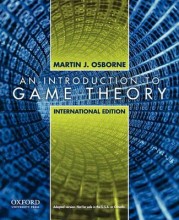Summary: An Introduction To Game Theory | 9780195322484
- This + 400k other summaries
- A unique study and practice tool
- Never study anything twice again
- Get the grades you hope for
- 100% sure, 100% understanding
Read the summary and the most important questions on An introduction to game theory | 9780195322484
-
2 Chapter 2. Nash equilibrium: theory
-
2.2 the Prisoners dilemma
-
What situation models the prisoner's dilemma?
A situation where the players gain from cooperation. -
2.3 Bach or Stravinsky
-
What is the different between Bach or Stravinsky and the prisoner's dilemma?
In Bach or Stravinsky, players work together but do not agree on what is the best outcome. -
2.6 Nach equilibrium
-
What is the Nash equilibrium?
An action profile of which non of the players can better the outcome by changing strategy. -
2.9 Dominated actions
This is a preview. There are 1 more flashcards available for chapter 2.9
Show more cards here -
What does it mean when a players action strictly dominates?
When the action stays the same no matter what the other player does -
3 Nash Equilibrium: Illustrations
-
3.1 Cournot's model of oligopoly
-
How did Cournot model the industry in a game?
Firms as players
Possible outputs as actions
profit as preferences -
3.2 Bertrand's model of oligopoly
This is a preview. There are 1 more flashcards available for chapter 3.2
Show more cards here -
What does the game look like with Bertrand's model?
Firms as players
possible prices as actions
profit as preferences -
3.3 Electoral competition
-
What does the game of Hotelling's model of electoral competition look like?
Candidates as players
set of positions as actions
payoffs of wins, losses and ties as preferences -
3.4 The War of Attrition
This is a preview. There are 1 more flashcards available for chapter 3.4
Show more cards here -
What models ideas does the war of attrition model elaborate on?
On the ideas of the Hawk-Dove game -
What does the game of war of attrition consists of?
Two parties to a dispute as players
possible concession times as actions (both prefer shorter)
payoffs as preference -
3.5 Auctions
This is a preview. There are 9 more flashcards available for chapter 3.5
Show more cards here -
What do auctions games consist of?
Bidders as players
possible bids as actions
payoffs of bid as preferences
- Higher grades + faster learning
- Never study anything twice
- 100% sure, 100% understanding
































